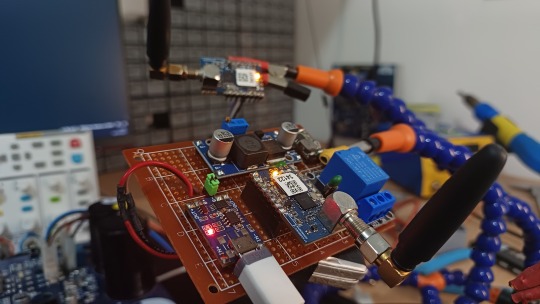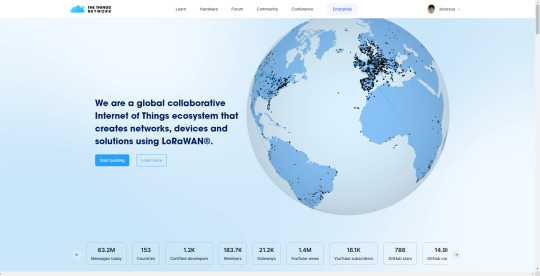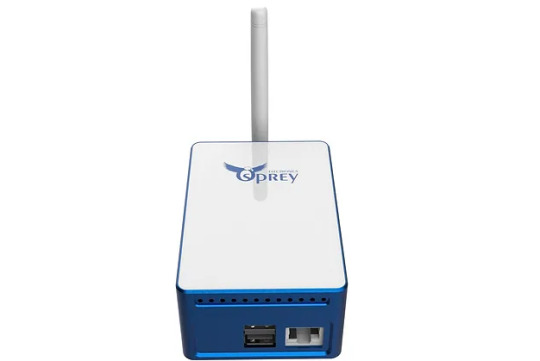#lorawan device
Text
Specification • PM2.5, PM10 based pollution Detection, • CO2 level monitoring for traffic density. • Auto path clearance for Ambulance and fire brigade based on RF communication to traffic light via Mobile/Web application MCU Specification • SX1262+STM8L152 integrated. • Frequency Range: 865MHz ~ 867MHz. • Maximum Power +21dBm constant RF
#Best LoRaWAN Air Pollution Monitoring#Hydraulic Trainer kit & Pneumatic Trainer kit manufacturers#LoRaWAN Air Pollution Monitoring system manufacturers#lorawan device#lorawan vs lora#lorawan temperature sensor#lorawan end node
0 notes
Text
Osprey Hotspot G1 (US, Europe, China)
Osprey Hotspot G1 is for PoC Helium network, mining HNT. It works with the Helium LongFi architecture, which integrates the leading wireless LoRaWAN protocol with the Helium Blockchain technology. All Osprey Hotspot G1 are compatible with LoRaWAN.
LongFi connects the LoRaWAN enabled IoT devices to the network, allowing any LoRaWAN device to send and receive data for the Internet of Things. LongFi provides roaming capabilities and micropayment transactions.
With the Osprey Hotspot G1, you can begin creating coverage for the Internet of things. Anyone can start delivering wireless network coverage over hundreds of square miles within a few minutes.
Complete set-up in minutes using a smartphone or remote dashboard
LongFi™ technology maximizes range and battery life
Low Power – uses as much power as a broadband router (12W)
Easily manage gateways from the mobile app
#helium hotspot#helium hotspot miner#hotspot miner helium#lorawan hotspot helium#cryptocurrency mining device#ethereum mining device#crypto mining device#crypto miner hotspot
0 notes
Text
Unveiling the Future: Crypto Hotspot Mining and Helium Hotspot Miners

Delve into the world of crypto hotspot mining with Helium Hotspot Miners. These devices facilitate decentralized wireless network coverage while earning cryptocurrency rewards. Learn about their role in the emerging IoT ecosystem and how they contribute to the blockchain network's infrastructure. Discover the potential of Helium hotspot miners and their impact on decentralized connectivity.
For More:
#crypto hotspot#crypto mining#helium hotspot#helium hotspot miner#hotspot miner helium#lorawan hotspot helium#cryptocurrency mining device
0 notes
Text
GPIOs do LoRaMesh da Radioenge: Portas digitais
Aprenda como usar as GPIOs do módulo LoRaMesh da Radioenge
As GPIOs do LoRaMesh da Radioenge possibilita que possamos fazer aplicações de automação com um uso reduzido de hardware, dedicando apenas ao circuito de chaveamento (se necessário) e de alimentação.
No total temos no LoRaMesh 8 GPIOs sendo todas configuráveis como entrada ou saída digital e duas como leitura analógica. Porém neste post vamos apenas abordar as portas digitais.
Por qual motivo…

View On WordPress
#lora mesh arduino#lora mesh chat#lora mesh device#lora mesh library#lora mesh module#lora mesh network#lora mesh network raspberry pi#lora mesh protocol#lora mesh radio#lora mesh range#lora vs lorawan#loramesh#lorawan#lorawan devices#lorawan gateway#lorawan network#mesh lora
0 notes
Text
Has the Internet of Things (IoT) changed our daily lives?
The Internet of Things (IoT) is drastically changing our lives, making everything more connected and accessible. IoT has made its way into everyday items, making them part of an information ecosystem that's reshaping our world.

So, how will IoT change the world? IoT has already revolutionized where and how work is done across various industries. It's ushering in the era of the Internet of Everything (IoE), connecting machines, people, processes, and data in ways that profoundly impact our daily lives.
Looking at real-life IoT examples, we see automated temperature control through thermostats, smart devices like Amazon Echo and Google Home, wearables tracking heart rates, home security systems, and voice-activated smart lighting systems.
IoT has a profound influence on our daily routines, transforming various aspects of our lives by harnessing the power of connectivity, data, and intelligent machines.
Smart Home Convenience: IoT has made our homes smarter and more convenient. We can control our thermostats, lights, and appliances remotely using smartphones or voice commands through devices like Amazon Echo and Google Home. Smart locks, cameras, and doorbells provide enhanced security and peace of mind.
Health and Wellness: Wearable IoT devices such as fitness trackers and smartwatches have become commonplace. They help individuals monitor their physical activity, heart rate, sleep patterns, and more. These devices encourage healthier lifestyles and empower people to take charge of their well-being.
Connected Transportation: IoT plays a significant role in transportation through applications like vehicle telematics and navigation systems. Smart cars can communicate with each other and with traffic infrastructure to optimize routes and enhance safety. Ride-sharing apps also rely on IoT for efficient matching and tracking.
Precision Agriculture: In agriculture, IoT sensors and devices monitor soil conditions, crop health, and weather data. Farmers can make data-driven decisions to optimize irrigation, fertilization, and pest control, increasing crop yields while conserving resources.
Healthcare: IoT has transformed healthcare with remote patient monitoring. Devices can track vital signs and transmit data to healthcare providers, allowing for early intervention and reducing the need for frequent hospital visits. IoT-enabled medical equipment also enhances patient care.
Retail and Shopping: IoT has changed the way we shop. Smart shelves and beacons in stores provide personalized offers and product recommendations. E-commerce benefits from IoT through inventory management, tracking deliveries, and optimizing supply chains.
Energy Efficiency: Smart meters and IoT-connected appliances enable homeowners to monitor and reduce energy consumption. This not only lowers utility bills but also contributes to environmental sustainability.
Industrial IoT (IIoT): In the industrial sector, IoT sensors and automation improve production processes, reduce downtime, and enhance overall efficiency. IIoT also enables predictive maintenance, saving both time and resources.
Environmental Monitoring: IoT is used for environmental monitoring and conservation efforts. Sensors collect data on air quality, water quality, and wildlife movement, aiding in environmental research and protection.
Smart Cities: IoT technologies are integral to smart city initiatives. They help manage traffic flow, optimize waste collection, enhance public safety, and provide real-time information to residents and visitors.
Supply Chain Optimization: Businesses use IoT to track goods and shipments throughout the supply chain. This improves inventory management, reduces losses, and ensures products reach consumers more efficiently.

In essence, IoT has become an integral part of modern life, affecting various aspects of our daily routines. Its ability to connect devices, collect data, and enable automation has brought about greater convenience, efficiency, and connectivity in nearly every industry and sector. As IoT continues to evolve, its impact on our lives will likely grow even more significant.
0 notes
Text
The Things Network: Primeiros passos
The Things Nework é o maior network server de LoRaWAN do planeta, sendo totalmente colaborativo e gratuito. Venha aprender a usar
A The Things Network ou TTN é um servidor de rede LoRaWAN colaborativa que permite que qualquer pessoa ou empresa possa ser um ponto de conexão LoRaWAN como também pode utilizar a cobertura já existente para conectar os end devices tudo de forma gratuita.
1 O que é The Things Network?
A TTN é um network server criado em 2015 com o objetivo de criar uma cobertura global e colaborativa de LoRaWAN…

Ver no WordPress
#arduino lorawan#arduino lorawan library#esp32 lorawan#lorawan#lorawan application server#lorawan concentrator#lorawan devices#lorawan distance#lorawan gateway#lorawan network#lorawan the things network#the things network#the things network gateway#the things network map
0 notes
Text
https://poisonedthoughts.com/lorawan-testers-for-range-coverage/
Lorawan Testers For Range Coverage. Coverage testing for LoRaWAN is very important, you may want to know more about the exact limits and limitations of LoRaWAN. Whether it’s to see if it’s compatible with a device located far from your home, whether it’s a wristwatch used outdoors, or perhaps a water or gas sensor placed underground. A coverage test helps you evaluate the coverage area of the WAN.
Villa owners with rental apartments can also try the offer. RAKwireless can help you achieve this goal effortlessly. The coverage test mainly depends on your specifications and is performed to help you find out the map or radius of your wireless network
1 note
·
View note
Text
Container Tracker

The Container Tracker is a device that integrates GNSS (GPS, Beidou, Glonass), Bluetooth, and LoRa technology for accurate outdoor and indoor positioning of assets. It has an IP68 enclosure that provides protection against water and dust ingress. It has a large battery capacity that can support up to 180,000 Bluetooth tracking messages over 30,000 GPS coordinates. It supports tracking up to 100 Bluetooth beacons and also supports UUID change to avoid interference from other devices.
For More:
3 notes
·
View notes
Text
Multi-Band Coverage Satellite Communication Module: Flexibly Adapting to Multiple Application Scenarios
The LoRa1121 module utilizes SEMTECH's LR1121 chip, an ultra-low-power, long-range transceiver that supports both global ISM band and 2.4GHz communication. The LoRa1121 supports LoRa and (G)FSK modulation in the Sub-GHz and 2.4GHz bands, as well as Sigfox® modulation in the Sub-GHz band, and long-range frequency hopping spread spectrum (LR-FHSS) in the Sub-GHz, 1.9-2.1GHz, and 2.4GHz ISM bands. The LR1121 complies with the physical layer requirements of the LoRaWAN® specifications released by the LoRa Alliance®, while remaining highly configurable to meet the needs of various applications and proprietary protocols.
Sub-GHz (150-960 MHz)
Frequency Range: Supports 433/470/868/915 MHz, and can be customized for frequencies between 150 and 960 MHz.
LoRa Modulation Rate: In the Sub-GHz band, the LoRa modulation rate ranges from 0.091 Kbps to 62.5 Kbps. Although the modulation rate is relatively low, LoRa's long-range transmission and strong anti-interference capabilities enable stable communication even at low bandwidths.
FSK Modulation Rate: The FSK modulation rate ranges from 0.6 Kbps to 300 Kbps. FSK modulation offers a higher modulation rate, suitable for applications requiring faster data transmission, though its transmission distance is shorter, making it appropriate for local data transmission.
Main Advantages: The Sub-GHz band excels in long-distance communication with a receiving sensitivity of up to -144 dBm @ BW=62.5 KHz, SF=12. It maintains efficient reception even at very low signal strengths, greatly enhancing the reliability of long-distance communication. The Sub-GHz band offers strong penetration and long-distance coverage capabilities.

S-Band (1.9 GHz - 2.2 GHz)
Frequency Range: 1900 MHz to 2200 MHz, covering satellite communication bands.
LoRa Modulation Rate: In the S-band (1900 MHz to 2200 MHz), the LoRa modulation rate ranges from 0.292 Kbps to 87.5 Kbps. Compared to the Sub-GHz band, the S-band LoRa modulation rate is slightly higher, making it particularly suitable for satellite communication and remote coverage applications, while maintaining long communication distances and low power consumption.
Main Advantages: The S-band is designed specifically to support satellite communication, suitable for long distances and scenarios with no ground network coverage. It has a receiving sensitivity of up to -132 dBm @ BW=125 KHz, SF=12. With high sensitivity, it maintains effective communication even at lower signal strengths, making it ideal for long-distance satellite links.
2.4 GHz Band
Frequency Range: 2400–2500 MHz, a globally used ISM band.
LoRa Modulation Rate: In the 2.4 GHz band, the LoRa modulation rate ranges from 0.476 Kbps to 87.5 Kbps. This band supports higher transmission rates and maintains good stability over short distances, making it suitable for applications with relatively large data volumes.
Main Advantages: This band supports higher data transfer rates, suitable for high-speed communication needs over short to medium distances, and is legally usable worldwide, ensuring good compatibility.

LR-FHSS (Long Range Frequency Hopping Spread Spectrum) Applicable Bands: Sub-GHz, S-Band, 2.4 GHz
LR-FHSS Technology: By hopping between multiple frequencies, LR-FHSS significantly enhances the system's resistance to interference and extends transmission distances. In the Sub-GHz, S-Band, and 2.4 GHz bands, LR-FHSS notably improves the stability and range of data transmission.
Communication Protocol Support
Supported Protocols: Supports Sigfox protocol and LR-FHSS (LoRa Time-Frequency Hopping Spread Spectrum Technology). These technologies and protocols further enhance communication interference resistance and device connectivity.
LoRaWAN Protocol: The LoRa1121 supports the LoRaWAN communication protocol, functioning as a LoRaWAN node for integration into existing LoRaWAN networks, providing reliable and flexible IoT connectivity solutions.
Characteristics of Sub-GHz Wireless Communication
Sub-GHz wireless communication operates at frequencies below 1 GHz and offers several advantages, including long-distance transmission, low power consumption, lower frequency congestion, and strong penetration capabilities. It is widely used in various applications.
Long-Distance Transmission: Sub-GHz signals have favorable propagation characteristics, allowing them to penetrate obstacles such as walls and vegetation. Consequently, under similar power conditions, the transmission distance is typically greater than that of higher frequency bands like 2.4 GHz, making it suitable for applications requiring wide-area coverage.
For details, please click:https://www.nicerf.com/products/
Or click:https://nicerf.en.alibaba.com/productlist.html?spm=a2700.shop_index.88.4.1fec2b006JKUsd
For consultation, please contact NiceRF (Email: [email protected]).
0 notes
Text
0 notes
Text
Embedded Software Design Services: Trends and Innovations

In the fast-paced world of technology, embedded software design is a crucial element driving the success of modern electronic devices. As industries continue to evolve, so do the methodologies and technologies shaping embedded software design services. This blog explores the latest trends and innovations that are transforming the field, highlighting how these developments are enhancing performance, efficiency, and capabilities.
The Rise of AI and Machine Learning Integration
Artificial Intelligence (AI) and Machine Learning (ML) are no longer just buzzwords—they’re integral components of contemporary embedded software design. AI and ML algorithms are being embedded directly into devices, allowing for real-time data analysis and decision-making. This integration enables devices to learn from their environment and adapt their behavior, resulting in smarter and more efficient systems.
For example, AI-driven predictive maintenance in industrial equipment helps anticipate failures before they occur, reducing downtime and maintenance costs. In consumer electronics, AI enhances user experiences by personalizing recommendations and improving interaction through natural language processing.
Growing Importance of Edge Computing
Edge computing is revolutionizing embedded systems by shifting data processing closer to the source of data generation. This trend is particularly significant for applications requiring low latency and high-speed processing, such as autonomous vehicles and industrial automation.
By processing data at the edge, embedded systems can deliver faster responses and reduce the need for constant communication with central servers. This approach not only enhances performance but also improves data privacy and security by minimizing the amount of sensitive information transmitted over networks.
Advances in IoT Connectivity
The Internet of Things (IoT) continues to expand, and with it, the demand for robust and reliable connectivity solutions in embedded systems. Innovations in IoT connectivity, such as 5G technology, are driving new possibilities for embedded software design.
5G networks offer significantly higher speeds and lower latency compared to previous generations, enabling real-time communication and data exchange between devices. This is crucial for applications like smart cities, where numerous devices need to work seamlessly together to optimize resources and services.
Moreover, advancements in wireless protocols, such as Bluetooth 5.0 and LoRaWAN, are enhancing connectivity for various IoT applications, from wearables to agricultural sensors. These technologies provide improved range, lower power consumption, and better interference resistance.
Enhanced Security Measures
As embedded systems become more interconnected, security remains a top priority. The rise in cyber threats and data breaches underscores the need for robust security measures in embedded software design.
Innovations in cybersecurity for embedded systems include the implementation of advanced encryption techniques, secure boot mechanisms, and real-time threat detection systems. These measures help safeguard sensitive information and ensure the integrity of embedded devices against potential attacks.
Additionally, the use of hardware security modules (HSMs) and trusted execution environments (TEEs) is becoming more common. These technologies provide isolated environments for sensitive operations, adding an extra layer of protection to embedded systems.
Focus on Energy Efficiency
Energy efficiency is a critical consideration in embedded software design, especially for battery-powered devices and systems operating in remote or challenging environments. The trend towards energy-efficient design is driven by the need to extend battery life and reduce the environmental impact of electronic devices.
Recent innovations in low-power design techniques, such as dynamic voltage and frequency scaling (DVFS) and energy-efficient coding algorithms, are helping to minimize power consumption without compromising performance. Additionally, the development of energy-harvesting technologies is enabling devices to generate their own power from environmental sources, further enhancing sustainability.
Adoption of Modular and Scalable Architectures
Modular and scalable architectures are gaining traction in embedded software design, offering greater flexibility and ease of customization. Modular design allows for the creation of reusable components that can be easily adapted or replaced as needed, reducing development time and costs.
Scalable architectures enable systems to grow and evolve with changing requirements. This approach is particularly valuable in industries like telecommunications and automotive, where systems must be able to accommodate future upgrades and expansions without requiring a complete redesign.
The Role of Open-Source Software
Open-source software is playing an increasingly important role in embedded systems development. By leveraging open-source platforms and tools, developers can access a wealth of resources and collaborate with a global community of contributors. This fosters innovation and accelerates development cycles.
Open-source projects such as Linux-based operating systems and middleware frameworks provide a robust foundation for embedded software design. They offer flexibility, customization options, and a broad range of features that can be tailored to specific applications.
Embracing Agile Development Practices
Agile development practices are transforming the way embedded software is designed and developed. Agile methodologies, such as Scrum and Kanban, emphasize iterative development, collaboration, and responsiveness to change.
These practices enable development teams to adapt quickly to evolving requirements and incorporate feedback more effectively. By adopting agile approaches, organizations can improve project outcomes and deliver high-quality embedded software that meets user needs and expectations.
Conclusion
The landscape of embedded software design services is rapidly evolving, driven by advancements in AI, edge computing, IoT connectivity, and more. By staying abreast of these trends and innovations, organizations can leverage cutting-edge technologies to create smarter, more efficient, and secure embedded systems. Embracing these changes will not only enhance the capabilities of embedded devices but also position businesses at the forefront of technological progress.
To Know More About ,
#embedded systems#iot#embedded software#embedded software development#embedded design#embedded system#embedded
0 notes
Text
Energy Innovations, Community Care and a Solar Co-Op to Power Allambi Care’s Charlestown Offices
Energy Innovations Lake Macquarie City Council and a member-owned energy cooperative are working together on the community’s first solar project. The partnership invites around two hundred local residents to invest in a new system that will power Allambi Care’s Charlestown offices.
The $75 million NSW Emerging Energy Program supports the development of innovative large-scale electricity and storage projects. Grants are available for both capital projects and pre-investment studies.
Solar Panels Lake Macquarie
Solar Panels Lake Macquarie has been supplying, installing and servicing solar energy systems for the last 15 years. They specialize in high performance solar panels, inverters and batteries for homes and businesses. They also offer a range of energy efficient solar solutions such as solar water heaters and EV chargers.
They work with their customers to design the best possible system for their energy needs. They have a local team of solar specialists who understand the unique conditions of the area and are able to ensure that the correct componentry is used in each installation. This ensures that the system will perform as expected for its entire lifespan, regardless of the weather conditions.
Solar energy can save you money on your electricity bills and help reduce your carbon footprint. It can even provide a good return on investment, especially when you feed any surplus power back into the grid and get paid for it.
Depending on the size of your system, its location and your self-consumption rate you could save up to $1,583 per year. This is based on a 6.6kW system installation and the low end of the feed in tariff range at 5c per kWh.
ProvenExpert Reviews
A partnership between the local government, a not for profit leading provider of community care and a solar co-operative has enabled the installation of Australia’s first smart city network in Lake Macquarie. The long-range wide area network (LoRaWAN) for the Internet of Things will enable start-ups and large businesses to develop new technology and make better decisions using real-time data, Lake Macquarie Mayor Paul Fletcher said.
The network, which covers 650 square kilometres of the municipality, will be commercially funded for 20 years by the National Narrowband Network Company (NNNCo), with major entities such as University of Technology Sydney, Hunter Water, Slingshot, Ampcontrol, BinShare and ResTech already signed on to connect. The project is also supported by the Australian Government through its Smart Cities program.
Get Started Today
In a first for Lake Macquarie, a partnership between local government, a not-for-profit leading community care organisation and a solar cooperative is set to make the city a pioneer in renewable energy in the Hunter. The project will see Allambi Care, the not for profit community service provider, work with the Pingala Co-operative and around two hundred members of the local community to finance a solar power system on its Charlestown offices.
Part of this is the result of Council's efforts to cut its energy use, including implementing onsite generation, installing more efficient lighting and switching off unnecessary lights in office buildings. It's also a result of Council's Circular Economy Lead Debbie O’Byrne's work in developing a circular economy policy and framework for the city.
This includes partnering with carrier-grade IoT network National Narrowband Network Co (NNNCo) to roll out a new smart city network using its LoRaWAN technology for the Internet of Things (IoT). Smart cities need both a network and a device and data platform that converts data from many different kinds of devices into a common format, which is what the NNNCo solution will provide. The network will be used to support a range of IoT applications, including water, waste and environment, transport, infrastructure and energy, agriculture and education.
0 notes
Text
Osprey Hotspot G1 (US, Europe, China)

Understand how Helium's network uses LoRaWAN technology for IoT connectivity and rewards in cryptocurrency, versus traditional Ethereum mining devices focused on blockchain transactions. Learn about their unique functions, benefits, and how they contribute to the expanding digital landscape. Osprey Hotspot G1 is for PoC Helium network, mining HNT. It works with the Helium LongFi architecture, which integrates the leading wireless LoRaWAN protocol with the Helium Blockchain technology. All Osprey Hotspot G1 are compatible with LoRaWAN.
LongFi connects the LoRaWAN enabled IoT devices to the network, allowing any LoRaWAN device to send and receive data for the Internet of Things. LongFi provides roaming capabilities and micropayment transactions.
For More:
#crypto hotspot#crypto mining#helium hotspot#helium hotspot miner#hotspot miner helium#lorawan hotspot helium#cryptocurrency mining device#ethereum mining device
0 notes
Text
Leitura analógica do LoRaMesh da Radioenge
Aprenda como usar a leitura analógica com o módulo LoRaMesh da Radioenge
A leitura analógica com o LoRaMesh possibilita com que possamos fazer um amplo sistema de sensoriamento remoto sem precisar necessariamente de microcontrolador adicional na parte do slave.
Por qual motivo usar a leitura analógica do LoRaMesh da Radioenge?
Uma leitura digital em muito dos casos já é mais que o suficiente para saber se algo está ou não funcionando, mas a leitura analógica do…

View On WordPress
#lora mesh arduino#lora mesh chat#lora mesh device#lora mesh library#lora mesh module#lora mesh network#lora mesh network raspberry pi#lora mesh protocol#lora mesh radio#lora mesh range#lora vs lorawan#loramesh#lorawan#lorawan devices#lorawan gateway#lorawan network#mesh lora
0 notes
Text
What is the difference between the LoRaWAN wireless module and LoRa gateway wireless transmission technology?
Many individuals find it challenging to differentiate between the LoRaWAN wireless module and LoRa gateway wireless transmission technology, as well as their applications within the realm of IoT.

LoRaWAN specifically pertains to the networking protocol found within the MAC (Media Access Control) layer. In contrast, LoRa serves as a protocol within the physical layer. Although current LoRaWAN networking implementations utilize LoRa as the physical layer, it's worth noting that the LoRaWAN protocol also allows for the use of GFSK (Gaussian Frequency-Shift Keying) as the physical layer in specific frequency bands. From a network layering perspective, LoRaWAN can adopt various physical layer protocols, just as LoRa can serve as the physical layer for other networking technologies.
LoRa, as a technology, falls under the category of LPWAN (Low-Power Wide-Area Network) communication technologies. It represents an ultra-long-distance wireless transmission method based on spread spectrum technology, pioneered and promoted by Semtech in the United States. This approach revolutionizes the previous trade-off between transmission distance and power consumption, offering users a straightforward system capable of achieving extended range, prolonged battery life, and increased capacity. Consequently, it expands the capabilities of sensor networks. Currently, LoRa predominantly operates within free frequency bands globally, including 433/868/915MHz, among others.
On the other hand, LoRaWAN wireless communication stands as an open standard defining the communication protocol for LPWAN technology based on LoRa chips. LoRaWAN defines the Media Access Control (MAC) layer at the data link level and is overseen by the LoRa Alliance. It's crucial to distinguish between LoRa and LoRaWAN because companies like Link Labs utilize a proprietary MAC layer in conjunction with LoRa chips to create more advanced hybrid designs, such as Link Labs' Symphony Link.
LoRaWAN typically employs a star or star-to-star topology, which is generally considered superior to mesh networks due to advantages such as conserving battery power and extending communication range. In a star topology, messages are relayed to a central server through gateways, and each end node can transmit data to multiple gateways. These gateways then forward the data to the web server, where tasks like redundancy detection, security checks, and message scheduling are executed.
In summary, LoRa encompasses solely the link layer protocol, making it suitable for point-to-point (P2P) communication between nodes. In contrast, LoRaWAN includes the network layer, allowing data to be sent to any base station connected to a cloud platform. By connecting the appropriate antenna to its socket, the LoRaWAN module can operate at different frequencies, offering versatility in its applications.
0 notes